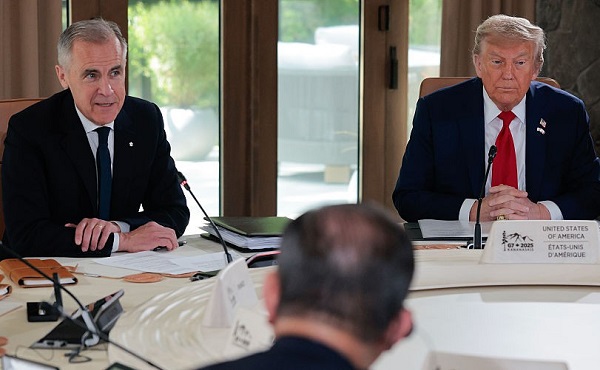Business
You are paying for our governments’ debt addiction

From the Fraser Institute
By Jake Fuss and Grady Munro
Ottawa and the provinces will together spend $82 billion on debt interest this year—equivalent to the total amount spent on K-12 education in Canada during 2020-21.
Budget season is approaching and while government debt has been increasing rapidly for years in Canada, today’s relatively high interest rates have made it more expensive to borrow money than in the recent past.
According to our new study published by the Fraser Institute, between 2007-08 and 2023-24 federal and provincial government net debt (i.e., total debt minus financial assets) has increased by roughly $1.0 trillion in inflation-adjusted dollars. Though pandemic-induced deficits explain part of that, fully 58 per cent of the run-up in debt occurred before COVID. That deserves emphasis: our current debt problems are not mainly the result of the pandemic.
Because both federal and provincial governments borrow—municipal governments not so much—Canadians face different government debt burdens depending on where they live. Newfoundland and Labradorians currently owe the largest combined (federal and provincial) government debt in Canada at $67,471 per person. Ontarians are not far behind at $60,609 while Albertans are in the best shape at $42,293.
In terms of debt-to-GDP ratios, the four Atlantic provinces are all currently above 85 per cent, which means it would take more than four out of every five dollars generated in the economy of each Atlantic province this year to pay off their combined federal and provincial debt.
Nova Scotians are worst off, with combined debt equivalent to 97 per cent of what their economy produces in a year. The national average debt-to-GDP ratio is projected to be 76 per cent this year, up significantly from before the pandemic.
Despite a surge in revenues, few Canadian governments are forecasting surpluses for the current fiscal year. Instead, Ottawa and the majority of provinces have chosen to increase their spending and debt and, in most cases, incur deficits for years to come.
This is a worrying trend, as many governments were already on unsustainable debt trajectories that they are now making worse. Governments need to restrain spending and move towards balanced budgets in the short term, while the economy is in relatively good shape, not put off difficult decisions for someone else to take at some future date.
Debt means always having to pay interest. Because their debts have grown and interest rates are higher than they have been for some time, Ottawa and the provinces will together spend $82 billion on debt interest this year—equivalent to the total amount spent on K-12 education in Canada during 2020-21.
Money that goes to interest can’t pay for tax cuts or spending on health care or education. It drives a wedge between the taxes we pay and the services we actually receive. And it burdens, not just today’s taxpayers, but future generations, too.
Growing government debt is not just another unpleasant COVID symptom. It was a problem well before COVID and it’s getting worse even though COVID is now mainly over. This budget season, our federal and provincial governments need to get their fiscal houses in order and stop their debt binging before it spirals even further out of control.
Authors:
Business
Trump family announces Trump Mobile: Made in America, for America

 MxM News
MxM News
Quick Hit:
On the 10-year anniversary of Donald Trump’s iconic campaign launch, the Trump family announced the debut of Trump Mobile, a new wireless company offering American-built smartphones, 5G coverage, and a values-driven alternative to Big Tech carriers.
Key Details:
-
Donald Trump Jr. and Eric Trump introduced Trump Mobile’s flagship service Monday, calling it a “transformational” alternative aimed at “our nation’s hardest-working people.”
-
The “47 Plan,” priced at $47.45/month, offers unlimited talk, text, and data, free international calls to U.S. military families, telehealth, roadside assistance, and no credit checks.
-
Trump Mobile’s customer support is fully U.S.-based and live 24/7—“not automated,” the company says—while a new American-made “T1 Phone” is slated for release in August.
Diving Deeper:
Marking ten years since President Donald Trump descended the golden escalator to launch his first campaign, the Trump Organization on Monday announced its boldest private sector move yet: Trump Mobile.
Flanked by company executives, Donald Trump Jr. and Eric Trump unveiled the new cellular service, touting it as a patriotic, people-first alternative to legacy providers. “We’re building on the movement to put America first,” Trump Jr. said in a statement. “We will deliver the highest levels of quality and service.”
The cornerstone of Trump Mobile is the 47 Plan. Offered for $47.45/month, the plan includes unlimited data, full 5G coverage across all three major carriers, and a suite of benefits tailored to middle-class families, truckers, veterans, and anyone tired of paying premiums to companies that don’t share their values.
Among the key perks: 24/7 American-based customer service (with “real people,” not bots), comprehensive device protection, roadside assistance through Drive America, and telehealth services including mental health support and prescription delivery. Most notably, the plan includes free international calling to over 100 countries—an effort the Trump family says honors U.S. military families stationed abroad.
“We’re especially proud to offer free long-distance calling to our military members and their families,” said Eric Trump. “Those serving overseas should always be able to stay connected to the people they love back home.”
Unlike traditional providers, Trump Mobile advertises no contracts and no credit checks, appealing to a demographic long underserved by mainstream telecom giants. “Hard-working Americans deserve a wireless service that’s affordable, reflects their values, and delivers reliable quality they can count on,” Eric Trump added.
The company is also preparing to launch the T1 Phone in August—a sleek, gold smartphone “engineered for performance” and “proudly designed and built in the United States.” With that, the Trump Organization is not just entering the mobile market—it’s staking a claim as a direct competitor to Apple and Samsung.
Business
Carney praises Trump’s world ‘leadership’ at G7 meeting in Canada

From LifeSiteNews
Canada’s prime minister said it was a ‘great honor’ to host the U.S. president and praised him for saying Canada wants to work with the U.S. ‘hand-in-hand.’
During the second day of the G7 leaders meeting in the Kananaskis area in Alberta, Canadian Prime Minister Mark Carney praised U.S. President Donald Trump’s world “leadership” despite saying many negative things about him during his election campaign.
While speaking to reporters Monday, Trump hinted that a new trade deal between Canada and the United States was potentially only “weeks” away. This came after a private meeting with Carney before the official G7 talks commenced.
“We’ve developed a very good relationship. And we’re going to be talking about trade and many other things,” Trump told reporters.
Carney was less vocal, however. He used the opportunity to tell reporters he was happy Trump came to his country for the G7 meeting, saying it was a “great honor” to host him.
“This marks the 50th birthday of the G7, and the G7 is nothing without U.S. leadership,” Carney told reporters.
He then spoke about Trump’s “personal leadership” on world issues and praised him for saying Canada wants to work with the U.S. “hand-in-hand.”
Carney ran his election campaign by claiming the Conservative Party would bow to Trump’s demands despite the fact that the party never said such things.
During his federal election campaign, Carney repeatedly took issue with Trump and the U.S. that turned into an anti-American Canadian legacy media frenzy.
However, the reality is, after Carney won the April 28 federal election, Trump praised him, saying, “Canada chose a very talented person.”
Many political pundits have said that Carney owes his win to Trump, as the U.S. president suggested on multiple occasions that he would rather work with Carney than conservative leader Pierre Poilievre.
Trump has routinely suggested that Canada become an American state in recent months, often making such statements while talking about or implementing trade tariffs on Canadian goods.
As for Carney, he has said his government plans to launch a “new economy” in Canada that will involve “deepening” ties to the world.
-

 conflict1 day ago
conflict1 day ago“Evacuate”: Netanyahu Warns Tehran as Israel Expands Strikes on Iran’s Military Command
-

 Health1 day ago
Health1 day agoLast day and last chance to win this dream home! Support the 2025 Red Deer Hospital Lottery before midnight!
-

 Energy1 day ago
Energy1 day agoCould the G7 Summit in Alberta be a historic moment for Canadian energy?
-

 Alberta2 days ago
Alberta2 days agoAlberta’s grand bargain with Canada includes a new pipeline to Prince Rupert
-

 Bruce Dowbiggin1 day ago
Bruce Dowbiggin1 day agoWOKE NBA Stars Seems Natural For CDN Advertisers. Why Won’t They Bite?
-

 Business2 days ago
Business2 days agoCarney’s European pivot could quietly reshape Canada’s sovereignty
-

 Aristotle Foundation22 hours ago
Aristotle Foundation22 hours agoThe Canadian Medical Association’s inexplicable stance on pediatric gender medicine
-

 Energy17 hours ago
Energy17 hours agoKananaskis G7 meeting the right setting for U.S. and Canada to reassert energy ties








